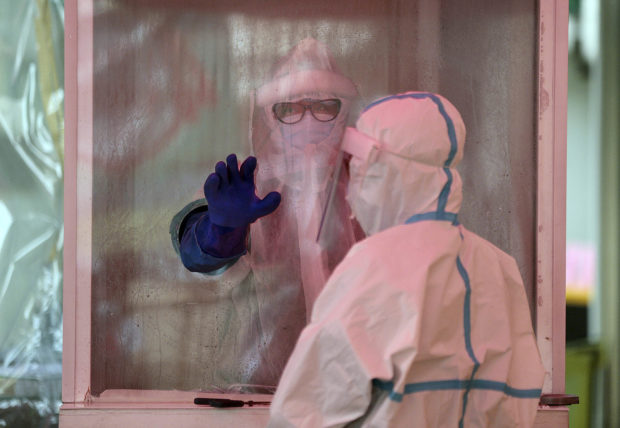Saliva-based tests for COVID-19 eyed

TRIED AND TESTED Health workers conduct swab testing in Quezon City. (Photo by GRIG MONTEGRANDE / Philippine Daily Inquirer)
MANILA, Philippines — The Department of Health (DOH) is looking into whether saliva-based tests can be an “acceptable and feasible” method to detect new coronavirus infections.
Health Undersecretary Maria Rosario Vergeire said that studies were still ongoing to determine if the country could supplement its current testing efforts by using saliva-based tests for COVID-19.
Vergeire said the Research Institute for Tropical Medicine (RITM) was conducting the studies.
This developed as an additional 3,637 COVID-19 cases were recorded on Saturday, bringing the total number of cases to 213,131.
Of the new cases submitted by 102 out of 110 accredited laboratories, 3,063 were infected between Aug. 16 and 29, while 416 got sick between Aug. 1 and 15.
Article continues after this advertisementMetro Manila recorded the highest number of new cases at 2,030, followed by Laguna (217), Rizal (155), Cavite (142) and Batangas (113). There are now a total 74,611 active cases, of which 91.3 percent are mild, 6.7 percent asymptomatic, 0.8 percent severe and 1.1 percent critical.
Article continues after this advertisementThe total number of recoveries rose to 135,101 after 655 more patients recovered.
The death toll, however, rose to 3,419 as 94 patients succumbed to the severe respiratory disease.
Of the newly reported deaths, 81 died this month, 12 in July and one in June. Fifty-four of the fatalities were from Metro Manila, 16 from Calabarzon, 14 from Central Luzon, four from Western Visayas, three from Zamboanga and one from Central Visayas. A returning overseas Filipino and another patient from a yet to be determined locality also died from COVID-19.
The saliva-based tests will involve the collection of samples from a patient’s saliva.
Currently, samples are collected using nasopharyngeal or oropharyngeal swabs, which are “really inconvenient for a person” as a stick is inserted through a person’s nose or throat.
Vergeire noted that sample collection would be much easier for saliva-based tests since the health worker needed only to rub a sponge on the sides of a patient’s mouth.
The disadvantage, however, is that current studies on this collection method show that the samples obtained from patients may be contaminated.
“Some articles are saying that there are always food particles so it contaminates the specimen. Second, to get accurate results you should collect a lot [of saliva]. So you should correctly rub the sides of a person’s mouth to get enough yield,” Vergeire said
“As soon as RITM gets initial results, we’ll share it with everybody because this is something worth pursuing if it could really help and we see that it is acceptable and feasible for our testing strategy,” she added
In the United States, its Food and Drug Administration (FDA) recently issued an emergency authorization to Yale School of Public Health to use the SalivaDirect test kit, which did not require a separate nucleic acid extraction step.
“This is significant because the extraction kits used for this step in other tests have been prone to shortages in the past. Being able to perform a test without these kits enhances the capacity for increased testing, while reducing the strain on available resources.,” the US FDA said in a statement
“Since the saliva sample is self-collected under the observation of a health-care professional, it could also potentially lower the risk posed to healthcare workers responsible for sample collection,” it added.